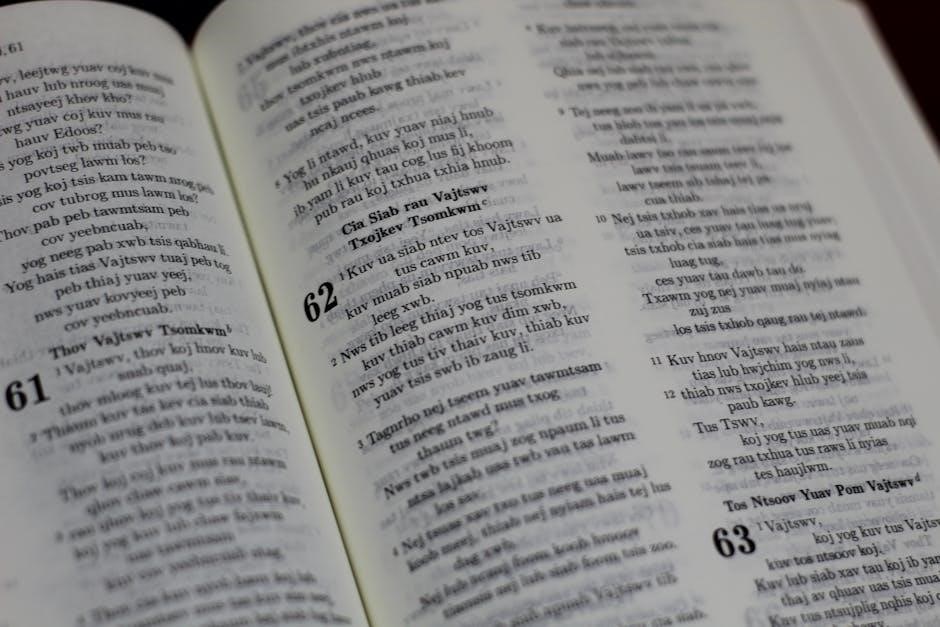Act 1 of Romeo and Juliet introduces the bitter feud between Montagues and Capulets, setting the stage for the tragic love story of Romeo and Juliet․

The Prologue of Act 1
The Prologue, a 14-line sonnet, introduces Verona’s feud between Montagues and Capulets, foreshadowing the tragic fate of the two lovers and their families’ conflict․
2․1․ Setting the Context of the Feud
The Prologue establishes the historical and societal backdrop of Verona, highlighting the long-standing rivalry between the Montagues and Capulets․ It introduces the Chorus, who narrates the conflict, emphasizing the destructive nature of the feud․ The Prologue sets the stage for the tragic events, revealing how the families’ hatred disrupts Verona’s peace․ This ancient grudge is central to the play’s tension and ultimately shapes the fate of the star-crossed lovers, Romeo and Juliet․
The Chorus serves as the narrative voice, providing context and foreshadowing key events․ It appears at the beginning of each act, offering insight into the underlying themes and conflicts․ The Chorus’s role is to guide the audience through the story, highlighting the inevitability of the tragic outcome․ This literary device creates a connection between the audience and the action on stage, while also underscoring the universal themes of fate and love that drive the play’s dramatic progression․

Act 1, Scene 1
Act 1, Scene 1 opens with Capulet servants Sampson and Gregory discussing their hatred for Montagues․ A brawl ensues, Benvolio attempts to calm tensions, but Tybalt arrives, escalating the conflict․ The Prince intervenes to restore order in Verona․
3․1․ The Feud Between Montagues and Capulets
The feud between the Montagues and Capulets is central to Act 1, Scene 1․ Their hatred is deeply ingrained, with Sampson and Gregory openly expressing hostility․ The brawl between the families showcases the intensity of their rivalry, highlighting a long-standing conflict that disrupts Verona’s peace․ The Prince’s intervention underscores the societal impact of their animosity, setting the stage for tragic consequences․
Sampson and Gregory, servants of the Capulet household, are introduced in Act 1, Scene 1․ Their conversation reveals their deep-seated hatred for the Montagues․ Sampson boasts about his aggression, while Gregory shares his desire for conflict․ Their dialogue highlights the bitter rivalry between the families․ The two servants engage in bawdy banter, showcasing their personalities—Sampson’s arrogance and Gregory’s loyalty․ Their interaction sets the tone for the feud’s intensity and foreshadows the violent clashes to come․
3․3․ The Arrival of Tybalt and Benvolio
Tybalt, a fierce Capulet, and Benvolio, a calm Montague, arrive in Scene 1, escalating the tension․ Tybalt is eager to confront the Montagues, while Benvolio seeks peace․ Their encounter highlights their contrasting personalities—Tibalt’s aggression versus Benvolio’s diplomacy․ The scene underscores the families’ animosity and sets the stage for future conflicts․ Benvolio’s attempt to defuse the situation contrasts sharply with Tybalt’s fiery temperament, foreshadowing the tragic events that will unfold due to their families’ hatred․

Act 1, Scene 2
Lord Capulet discusses Juliet’s marriage to Paris, emphasizing her duty․ Juliet is introduced, showcasing her youth and obedience․ The scene highlights familial expectations and societal pressures․
4․1․ Lord Capulet’s Plan for Juliet’s Marriage
Lord Capulet arranges Juliet’s marriage to Paris, believing it a suitable match․ He emphasizes the importance of loyalty and duty to secure the family’s legacy․ Juliet’s youth and beauty are highlighted as reasons for the union, reinforcing societal expectations of women in Verona․ The plan underscores the theme of family honor and the lack of personal choice for women in Shakespearean society․
Paris, a wealthy and well-connected suitor, is introduced as a potential husband for Juliet․ Lord Capulet views Paris as an ideal match, praising his noble status and desirable qualities․ Paris’s charm and eligibility make him a suitable candidate, aligning with the family’s aspirations․ His introduction highlights the societal norms of arranged marriages and the importance of securing advantageous alliances in Verona’s elite circles․
4․3․ Juliet’s First Appearance
Juliet’s first appearance occurs in Act 1, Scene 2, where she is introduced as a young, naive, and obedient daughter․ The Nurse fondly recalls Juliet’s childhood, emphasizing her innocence and growth․ Juliet’s parents discuss her potential marriage to Paris, highlighting her societal role․ Juliet’s hesitation and lack of enthusiasm foreshadow her independence and eventual defiance, showcasing her transition from childhood to adulthood and setting the stage for her pivotal decisions․

Act 1, Scene 3
Lady Capulet and the Nurse discuss Juliet’s upcoming marriage to Paris, while Juliet expresses hesitation․ The Nurse recalls Juliet’s childhood, highlighting her growth and innocence․
5․1․ Juliet and Her Parents Discuss Marriage
Lady Capulet informs Juliet of Paris’ proposal, praising his wealth and status․ Juliet hesitates, expressing uncertainty about marriage, while her parents insist it’s a favorable match, emphasizing obedience and duty․ Lady Capulet’s persuasion contrasts with Juliet’s silent resistance, highlighting her internal conflict and the societal expectations placed upon her as a young woman in Verona․
5․2․ The Nurse’s Memories of Juliet
The Nurse fondly recalls Juliet’s childhood, sharing a heartfelt memory of her as a baby․ She reminisces, “Thou wast the prettiest babe that eer I nursed,” highlighting Juliet’s innocence and charm․ The Nurse’s affectionate tone underscores her deep bond with Juliet, while also emphasizing Juliet’s rapid growth from infancy to adolescence, preparing the audience for her impending transition into adulthood and the challenges it will bring․
5․3․ Juliet’s Reaction to the Marriage Proposal
Juliet expresses uncertainty and hesitation when her parents propose marriage to Paris․ She politely requests time to consider, showing her youth and naivety․ Her response highlights the societal expectations placed upon her, as she struggles with the idea of marrying a man she does not know․ Juliet’s cautious demeanor foreshadows her later defiance, revealing the internal conflict between obedience to her parents and her own desires, setting the stage for her eventual rebellion․

Main Characters Introduced in Act 1
Act 1 introduces Romeo, Juliet, Sampson, Gregory, Tybalt, Benvolio, Lord and Lady Capulet, and the Chorus, establishing their roles and affiliations in the conflict․
6․1․ Romeo Montague
Romeo Montague is a young, passionate, and emotional nobleman․ In Act 1, he appears lovesick over Rosaline, showcasing his romantic nature․ His loyalty to his family is evident, yet his heart leads him to unexpected places․ Romeo’s impulsive decisions and deep feelings set the foundation for the tragic events․ His introduction highlights his vulnerability and the influence of love on his actions, making him a central figure in the unfolding drama․
6․2․ Juliet Capulet
Juliet Capulet is introduced as a young, innocent, and obedient daughter deeply loyal to her family․ Her parents discuss her potential marriage to Paris, highlighting her naivety about love․ Juliet’s initial appearance showcases her purity and kindness, as well as her desire to please her parents․ Her character begins to reveal a quiet strength and curiosity about her future, setting the stage for her eventual independence and emotional depth in the story․
6․3․ Benvolio and Tybalt
Benvolio, a Montague, is a calm and rational character who tries to mediate conflicts, while Tybalt, a Capulet, is hot-tempered and eager for a fight․ Their contrasting personalities highlight the tension between the two families; Benvolio’s empathetic nature is shown as he tries to comfort Romeo, while Tybalt’s aggression escalates the feud․ Their encounter in the street brawl underscores their roles as representatives of their families’ animosity, setting the stage for future conflicts in the play․
6․4․ Lord and Lady Capulet
Lord Capulet, a wealthy and influential nobleman, is eager to secure his family’s future through Juliet’s marriage to Paris․ He is authoritative and willing to enforce his will, reflecting the societal norms of Verona․ Lady Capulet, Juliet’s mother, supports her husband’s decision, emphasizing the importance of social status and family loyalty․ Together, they embody the traditional values of their society, prioritizing their daughter’s marital arrangement over her personal desires, which heightens the familial tension and sets the stage for Juliet’s rebellion․
6․5․ The Chorus
The Chorus serves as a narrator, providing context and thematic insights in Romeo and Juliet․ In Act 1, the Chorus introduces the feud between Montagues and Capulets, setting the tragic tone․ Speaking in poetic language, the Chorus highlights fate’s role in the lovers’ lives, emphasizing the inevitability of their doomed love․ This narrative device bridges scenes and underscores the play’s central themes, offering a broader perspective on the unfolding drama and the characters’ destinies․

Themes in Act 1
Act 1 explores themes of feud, love’s power, fate, and illusion vs․ reality․ These themes are introduced through the rivalry and doomed love story, setting the tragic tone․
7․1․ The Feud
The feud between Montagues and Capulets dominates Act 1, fueling hatred and violence․ The Prologue highlights their “ancient grudge” and “mutiny” in Verona․ Sampson and Gregory’s aggressive banter and Tybalt’s fiery temperament illustrate the deep-seated animosity․ This rivalry creates a tense atmosphere, leading to public brawls and setting the stage for tragic events․ The feud is not just a backdrop but a driving force behind the characters’ actions and the play’s ultimate devastation․
7․2․ Love vs․ Hate
Act 1 explores the contrasting themes of love and hate, central to the play․ Romeo’s lovesickness for Rosaline and his instantaneous love for Juliet highlight love’s transformative power․ Conversely, the brawl between Montagues and Capulets showcases deep-seated hatred․ The feud’s intensity is evident in Tybalt’s aggression and the servants’ animosity; Love emerges as a unifying force when Romeo and Juliet meet, yet their families’ hatred looms, foreshadowing tragedy․ This duality underscores the play’s emotional complexity and tragic undertones․
7․3․ Fate
Act 1 introduces fate as a dominant theme, with the Chorus hinting at the inevitable tragic outcome of the “star-cross’d lovers․” Romeo’s belief in fortune and his chance encounter with Juliet at the ball emphasize the role of destiny․ The prologue’s reference to their “fatal loins” underscores the idea that their families’ hatred seals their fate․ Thus, Act 1 establishes fate as a guiding force, setting the stage for the irreversible events that will unfold․
7․4․ Appearances vs․ Reality
In Act 1, the theme of appearances vs․ reality emerges through characters like Sampson and Gregory, who boast about hating Montagues but avoid confrontation․ Romeo’s infatuation with Rosaline contrasts with his instant attraction to Juliet, revealing his deceptive perception of love․ Similarly, Lord Capulet presents himself as a protective father while manipulating Juliet’s future․ These contradictions highlight the tension between outward appearances and inner truths, foreshadowing the deception that will unfold in the play․
Motifs in Act 1
Key motifs in Act 1 include light and dark, symbolizing love and conflict, and love as a force driving characters’ actions and decisions․
8․1․ Light and Dark
Light symbolizes love, hope, and purity, often associated with Romeo and Juliet’s romantic encounters․ Dark represents conflict, hatred, and fate, reflecting the feud and tragic outcomes․ This contrast emphasizes the struggle between love and violence, creating dramatic tension․ Shakespeare uses these motifs to foreshadow the inevitable clash of emotions and events, highlighting the themes of love’s beauty and the darkness of familial hatred․
8․2․ Love as a Force
Love is portrayed as an overpowering and transformative force in Act 1, driving characters’ actions and emotions․ Romeo’s infatuation with Rosaline and his instantaneous love for Juliet illustrate its compelling nature․ Love transcends rationality, as Romeo risks family loyalty to pursue Juliet․ This motif underscores the redemptive yet destructive potential of love, central to the play’s tragic trajectory․ Shakespeare highlights its universal impact, shaping destinies and fueling both hope and despair in Verona’s conflicted society․

The Role of the Chorus
The Chorus acts as a narrator, setting the scene and providing context for the feud and tragic events․ It offers commentary on the characters’ emotions and fate․
9․1․ Narrative Function
The Chorus serves as a guide, framing the story and providing essential background․ It introduces the feud and previews the tragic outcome, helping the audience understand the play’s direction and emotional depth․ Through its sonnets, the Chorus bridges scenes, highlighting key themes and foreshadowing events, thus enhancing the narrative structure and maintaining dramatic tension throughout Act 1․
9․2․ Thematic Highlighting
The Chorus emphasizes central themes like fate, love, and the destructive nature of the feud․ Its sonnets frame the story, highlighting the inevitability of tragedy and the characters’ emotional struggles․ By previewing the outcome, the Chorus underscores the fated collision of love and hatred, drawing the audience into the play’s emotional core and establishing the tragic tone that permeates Act 1․

Key Quotes from Act 1
From the Chorus: “From forth the fatal loins of these two foes,” highlighting fate’s role․ Romeo: “Why, such is love’s transgression,” capturing love’s complexities․
10․1․ “From forth the fatal loins of these two foes”
This quote, spoken by the Chorus, introduces the tragic origins of the feud between the Montagues and Capulets․ It highlights the inevitability of fate and the doomed legacy of the two families․ The phrase underscores the cyclical nature of their hatred, suggesting that their conflict is deeply rooted and unending․ This line sets the tone for the tragic events that will unfold, emphasizing the fateful consequences of their animosity and the ultimate sacrifice of the star-crossed lovers․
10․2․ “Why, such is love’s transgression․”
Romeo utters this line in Act 1, Scene 1, reflecting on the tormented nature of love․ It captures his melancholic view of romance, emphasizing its capacity to bring suffering alongside passion․ This quote highlights the paradoxical essence of love, where beauty and pain are intertwined․ Romeo’s words foreshadow the tragic consequences of his own love story, showcasing his idealistic yet doomed perception of love’s transformative power․
Act 1 introduces Verona’s feuding families, the Montagues and Capulets, and establishes the central conflict․ Romeo’s lovesickness for Rosaline contrasts with Juliet’s arranged marriage to Paris․
11․1․ Major Plot Points
The opening scene presents the Capulet servants’ hatred for Montagues, while Benvolio and Tybalt’s encounter escalates tension․ Lord Capulet arranges Juliet’s marriage to Paris, and Romeo, still pining for Rosaline, attends the Capulet ball, where he first meets Juliet, sparking their forbidden romance․
11․2․ Character Development
Act 1 establishes Romeo as a romantic, lovesick youth pining for Rosaline, while Juliet emerges as an obedient yet curious daughter․ Tybalt’s fiery temperament contrasts with Benvolio’s calm demeanor, highlighting their opposing views on conflict․ Lord and Lady Capulet reveal their authoritative expectations, and the Nurse provides comic relief while showcasing her deep affection for Juliet․ These introductions lay the groundwork for understanding their roles in the unfolding tragedy․

Analysis of Act 1
Act 1 masterfully introduces the feud, key characters, and dramatic tension, setting the stage for the tragic love story․ Shakespeare crafts a vivid portrayal of animosity and young love, foreshadowing the inevitable conflict through character interactions and dialogue․
12․1․ Dramatic Tension
Dramatic tension in Act 1 is ignited by the prologue, which highlights the feud’s intensity․
The confrontation between Sampson, Gregory, and Abram escalates the conflict․
Romeo’s unrequited love for Rosaline and his emotional turmoil add depth․
Tybalt’s fiery personality contrasts with Benvolio’s calm, foreshadowing clashes․
The Capulets’ plan to marry Juliet to Paris introduces familial tension․
These elements collectively create a charged atmosphere, setting the stage for the tragic events to unfold․
12․2․ Foreshadowing Events
Act 1 foreshadows the tragic outcome through the chorus’s warning of “star-cross’d lovers” and their ultimate demise․
Romeo’s melancholy and belief in fate hint at future sorrow․
The brawl in Scene 1 suggests ongoing violence between the families․
Lord Capulet’s plan to marry Juliet to Paris sets up her defiance and the lovers’ secret union․
These elements subtly prepare the audience for the devastating events that will unfold in later acts․
